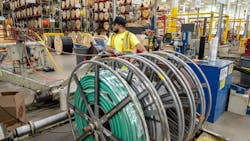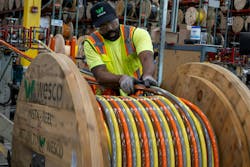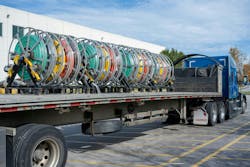Imagine hiring a five-star chef and expecting them to not only prepare a meal but also create the menu, shop for groceries, purchase all the cooking supplies, and even chop vegetables. You wouldn’t do that, of course, for two main reasons. First, the low-skill prep work could be done long before the chef arrives. Second, you want the highly specialized (and highly paid) chef focused on what they do best: cooking the meal. You don’t want to waste money paying the chef to perform tasks that just about anyone could do. In a construction environment, the same theory applies. You want the highly skilled and specialized workforce to focus on areas that only they are equipped and licensed to perform.
One labor productivity solution that electrical contractors can leverage is prefabricated (or prefab) solutions. This can help contractors get the maximum value out of skilled labor, which also is expensive and in short supply. While using prefab solutions isn’t a new approach, labor shortages and an increasing desire to maximize profitability bring these solutions to the forefront as a mechanism to improve efficiency and effectiveness in today’s tight labor market. But while it can be helpful, prefab solutions don’t apply to every situation. There are certain types of projects where they may be more relevant than others.
How this approach works
At its core, prefab solutions allow contractors or their distribution partners to leverage lower-skilled/cost labor to perform low-skill, often repetitive tasks off site — typically at their place of business instead of at the job site. This can encompass everything from unpacking products to assembling basic components (such as luminaires or electrical box assemblies) and then transporting them to the job site in a state where they can be simply installed by a licensed electrician. By executing these routine tasks off site, contractors can reduce their operating costs, while empowering skilled workers to focus on those tasks that only they are equipped to complete.
When to use it
Generally, prefab solutions are most effective on large-scale projects that have a lot of repetitive elements, such as hotels, multi-family homes, commercial buildings, and manufacturing facilities. In a hotel project, for example, there could be hundreds of similar-sized rooms — all with the same lighting and overall electrical design (e.g., all receptacles in the same spot). In this example, lighting kits can be assembled and pre-wired off site, allowing the electrical contractor to more quickly and efficiently install the equipment upon arrival to the job site.
Prefab solutions are also especially helpful on solar projects. Any solar project that uses more than three solar panels will need to incorporate a combiner box, which, as the name implies, combines the electrical output of multiple panels into a single circuit. Combiner boxes simplify the wiring structure and maintenance but take a significant amount of time to assemble. Using pre-built combiner boxes that arrive ready to install can materially reduce on-site labor and cost. And as the number of solar projects grows (along with their size and complexity), the importance of using solutions that save installation time cannot be understated.
With non-productive labor averaging 31% of a labor unit, a bit of ingenuity could help to optimize labor and ensure that a skilled worker’s time is not wasted on low-skill, repetitive processes. Utilizing prefab solutions can significantly cut down on the cost and scope of work executed at the job site.
There’s also an element of safety and comfort to consider in determining when to use prefab solutions. Contractors don’t always work in ideal conditions. They may have to wire or install service panels in extreme cold or work in a crawl space or attic that’s 110°F on a hot summer day. Utilizing prefab solutions can help cut down on time spent in extreme conditions. It can also allow contractors to leverage large equipment or automation processes that simply aren’t feasible in the field. In a market where labor is at a premium, helping to ensure comfortable working conditions can be a competitive advantage that attracts much-needed skilled workers.
Prefab best practices
If going the prefab route makes sense for your project, it’s also important to consider several best practices to ensure you’re maximizing your return on investment (ROI).
Understand when and where to use them: Utilizing prefab solutions offers several benefits, but might not make sense in every application. Does the size or scale of the project justify it? Does the job-site location or geographic footprint make prefab more cost-effective? Would it make your business more competitive in a bid, or create new opportunities?
Understand the volume you need to justify your investment: Prefab operations can encompass anything from a few people to a 100,000-square-foot facility with dozens of employees and large, complex equipment. Regardless of the investment level, you want to ensure workers consistently have projects to work on to justify the cost.
Lean on value-added partners: Partners can be especially helpful when it comes to utilizing prefab solutions effectively. At a minimum, they can help you understand if it makes sense for your project or business. In certain applications, they can even provide the prefab solution(s), such as a solar combiner box, freeing up worker time. They can also help amplify your team’s expertise and capabilities. For example, a commercial building project might also include installing advanced security cameras that incorporate sensors and analytic capabilities. If that falls outside your organization’s area of expertise, the right partner can provide the products pre-assembled, pre-configured, and ready to install.
Delivering on project execution
From supply chain challenges to labor shortages and rising labor costs, contractors are encountering new obstacles that can adversely impact on-time performance and their overall competitiveness and profitability. As projects continue to grow in size, scale, and complexity, these pressures will only intensify.
While prefab solutions have existed for decades, general and specialty trade contractors are increasingly using them to optimize labor performance and cost. They have proven to reduce costs, boost productivity, maximize skilled labor, and help contractors expand into new geographies to grow their business. As prefab capabilities continue to grow, contractors should consider whether these solutions could drive their business forward.
About the Author

Sean Nacey
Senior Vice President and General Manager
Sean R. Nacey, Senior Vice President and General Manager, U.S. Construction and Energy Solutions, Wesco.


